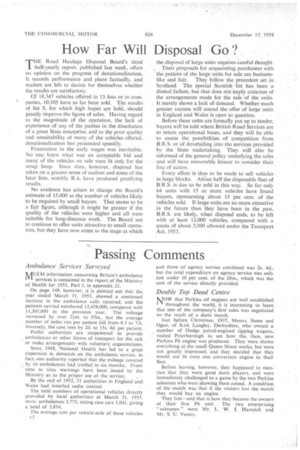Passing Comments
Page 40

Page 41

If you've noticed an error in this article please click here to report it so we can fix it.
Ambulance Services Surveyed
MUCH information concerning Britain's ambulance "I services is contained in the report of the Ministry of Health for 1953, Part 1, in appendix 21. On page 148, however, it is peinted out that the year ended March 31. 1953, showed a continued increase in the ambulance calls received, and the patients carried numbered 12,458,000, compared with 11,305,000 in the previous year. The mileage increased by over 21m. to 95m., but the average number of miles run per patient fell from 8.3 to 7.6. Inversely, the cost rose by 2d. to 15s. 4d. per patient. Public authorities are empowered to provide ambulances or other forms of transport for the sick or make arrangements with voluntary organizations. Since 1948, National Health has led to a great expansion in demands on the ambulance service, in fact, one authority reported that the mileage covered by its ambulances had trebled in six months. From time to time warnings have been issued by the Ministry as to the proper use of the service. By the end of 1952, 31 authorities in England and Wales had installed radio control.
The total numbers of operational vehicles directly provided by local authorities at March 31, 1953, were: ambulances 2,773, sitting case cars 1,041, giving a total of 3,814.
The average cost per vehicle-mile of these vehicles and those of agency service combined was 2s. 4d., but the total expenditure on agency service was only just under 10 per cent. of the i8m., which was the cost of the service directly provided.
Double Top Dead Centre
NOW that Perkins oil engines are well established throughout the world, it is interesting to learn that one of the company's first sales was negotiated on the result of a darts match.
Just before Christmas, 1937, Messrs. Stone and Ogan, of Kirk Langley, Derbyshire, who owned a number of Dodge petrol-engined tipping wagons, visited Peterborough to see how the, then, new Perkins P6 engine was produced. They were shown everything at the small Queen Street works, but were not greatly impressed, and they decided that they would not fit even one conversion engine to their fleet.
Before leaving, however, they happened to mention that they were good darts players, and were immediately challenged to a game by the two Perkins salesmen who were showing them round. A condition of the match was that if the visitors lost the match they would buy an engine.
They lost—and that is how they became the owners of their first P6 unit. The two enterprising " salesmen " were Mr. L. W. J. Hancock and Mr. S. U. Vestey.
A Detachable Upper Deck
nOUBLE-DECK buses have been prohibited in
Paris since 1913 and Parisians were, therefore, rather surprised to see a vehicle of that type on the streets again this year. The explanation is that this particular bus is not actually in public service and the regulation applies only to public service vehicles. It acts as a tender, conveying passengers from the Place de la Madeleine or the Place de L'Opera to the Solferino bridge, where they board one of the excursion boats on the Seine.
Some of our readers may remember the old " bateaux mouches " Which were such an attractive feature of Paris life for generations. This river service was dropped some years before the • last war, as it had ceased to pay. A year or two ago, however, three of the boats were purchased by a private company and trans formed into luxurious craft, which make trips from the Solferino bridge to Saint Cloud and back.
With regard to the bus, the mos' interesting feature is that it has a removable upper deck seating 18 passengers, access to which is gained by a staircase, also detachable, arranged inside the rear of the body. The top deck is uncovered and the idea of making it detachable is that when the summer tourist season ends and the • boats are laid up, the top can be removed and the roof replaced. The vehicle then becomes an ordinary coach and operates throughout the winter on normal hire service.
The chassis is a Berliet oiler and the body was specially designed by Pourtout.












































































































